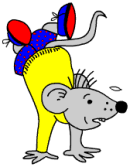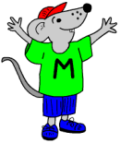Free Y5 maths worksheet: Probability
 Probably one of the least understood of maths concepts, especially with young children.
Probably one of the least understood of maths concepts, especially with young children.
Children should be able to say whether events are impossible , unlikely , likely or certain.
They should also be able to say which events have an even chance of happening (such as tossing a coin and getting a head), but they should be careful not to say that if there are two possibilities, they are equally likely. For example, there are two possibilities – I might buy a new BMW today or I might not. Unfortunately, these two events are not equally likely. Another example of this is I choose a number between 1 and 5. Is the number I choose a prime number? As there are three prime numbers between 1 and 5 (2, 3 and 5) and two numbers that are not, there is not an even chance that I will choose a prime number.
Sometimes further investigations have to be carried out before a probability question can be answered. Take the possibility of a factor of 16 being even. The only way of doing this is to first find all the factors of 16, group them into even or odd and then work out the probability.
Free Y5 maths worksheet: Probability (pg 3)
Free Y5 maths worksheet: Probability (pg 4)
 Here is a nifty way to carry out some subtraction sums in an original format. Use the shape on the free maths worksheet to make the subtraction sums by linking one number to another via the subtraction sign in the middle.
Here is a nifty way to carry out some subtraction sums in an original format. Use the shape on the free maths worksheet to make the subtraction sums by linking one number to another via the subtraction sign in the middle. This kind of work really shows whether a child has understood how numbers work and, in particular, that the value of a digit depends on its place in the number. This understanding is absolutely essential for making further progress.
This kind of work really shows whether a child has understood how numbers work and, in particular, that the value of a digit depends on its place in the number. This understanding is absolutely essential for making further progress. Very similar to the Year 4 worksheet sent up yesterday. By now children should be checking answers by using the reverse operation as a matter of course. Unfortunately, like most of us they probably don’t!
Very similar to the Year 4 worksheet sent up yesterday. By now children should be checking answers by using the reverse operation as a matter of course. Unfortunately, like most of us they probably don’t! Spatial awareness can differ enormously between children and indeed adults. This maths worksheet looks at a series of nets to see which can be folded to make an open box or open cube. Some children will be able to do this immediately. Others may well need to cut out the shapes and make them to see if it is possible.
Spatial awareness can differ enormously between children and indeed adults. This maths worksheet looks at a series of nets to see which can be folded to make an open box or open cube. Some children will be able to do this immediately. Others may well need to cut out the shapes and make them to see if it is possible. Two free maths worksheets, very similar to the year 4 ones on saying whether statements are true or false, with slightly harder numbers. This is revision of the following concepts:
Two free maths worksheets, very similar to the year 4 ones on saying whether statements are true or false, with slightly harder numbers. This is revision of the following concepts: Very similar to the year 4 worksheets on the same subject, this re-inforces and emphasises the importance of being able to explain the methods used to reach an answer. In the ‘Operation’ box the child should put whether to add, subtract, multiply or divide. The ‘Method’ refers to whether it was done mentally, with paper and pencil or with a calculator. The ‘How’ should give more detail as to exactly how the question was carried out: what maths was actually done to reach the answer.
Very similar to the year 4 worksheets on the same subject, this re-inforces and emphasises the importance of being able to explain the methods used to reach an answer. In the ‘Operation’ box the child should put whether to add, subtract, multiply or divide. The ‘Method’ refers to whether it was done mentally, with paper and pencil or with a calculator. The ‘How’ should give more detail as to exactly how the question was carried out: what maths was actually done to reach the answer. It is important that children have real confidence with adding any two digit numbers ( eg 42 and 58 ) and that they have a variety of strategies or approaches, depending on the numbers involved – sometimes it is easier to start with the tens, but not always. Constant practice, usually not on paper, of these tens and units additions will make larger mental addition much easier.
It is important that children have real confidence with adding any two digit numbers ( eg 42 and 58 ) and that they have a variety of strategies or approaches, depending on the numbers involved – sometimes it is easier to start with the tens, but not always. Constant practice, usually not on paper, of these tens and units additions will make larger mental addition much easier. Now we are getting to the real nitty-gritty of reading and writing large numbers up to millions. These are not easy: there are millions of adults in the UK who can not write
Now we are getting to the real nitty-gritty of reading and writing large numbers up to millions. These are not easy: there are millions of adults in the UK who can not write Probably one of the least understood of maths concepts, especially with young children.
Probably one of the least understood of maths concepts, especially with young children. Finding the difference between two numbers either side of a whole thousand is the focus of these two maths worksheets. But, even those these look hard they do not need to be done using written methods. Remember all that counting on we have been doing in earlier years; it comes into its own now.
Finding the difference between two numbers either side of a whole thousand is the focus of these two maths worksheets. But, even those these look hard they do not need to be done using written methods. Remember all that counting on we have been doing in earlier years; it comes into its own now.